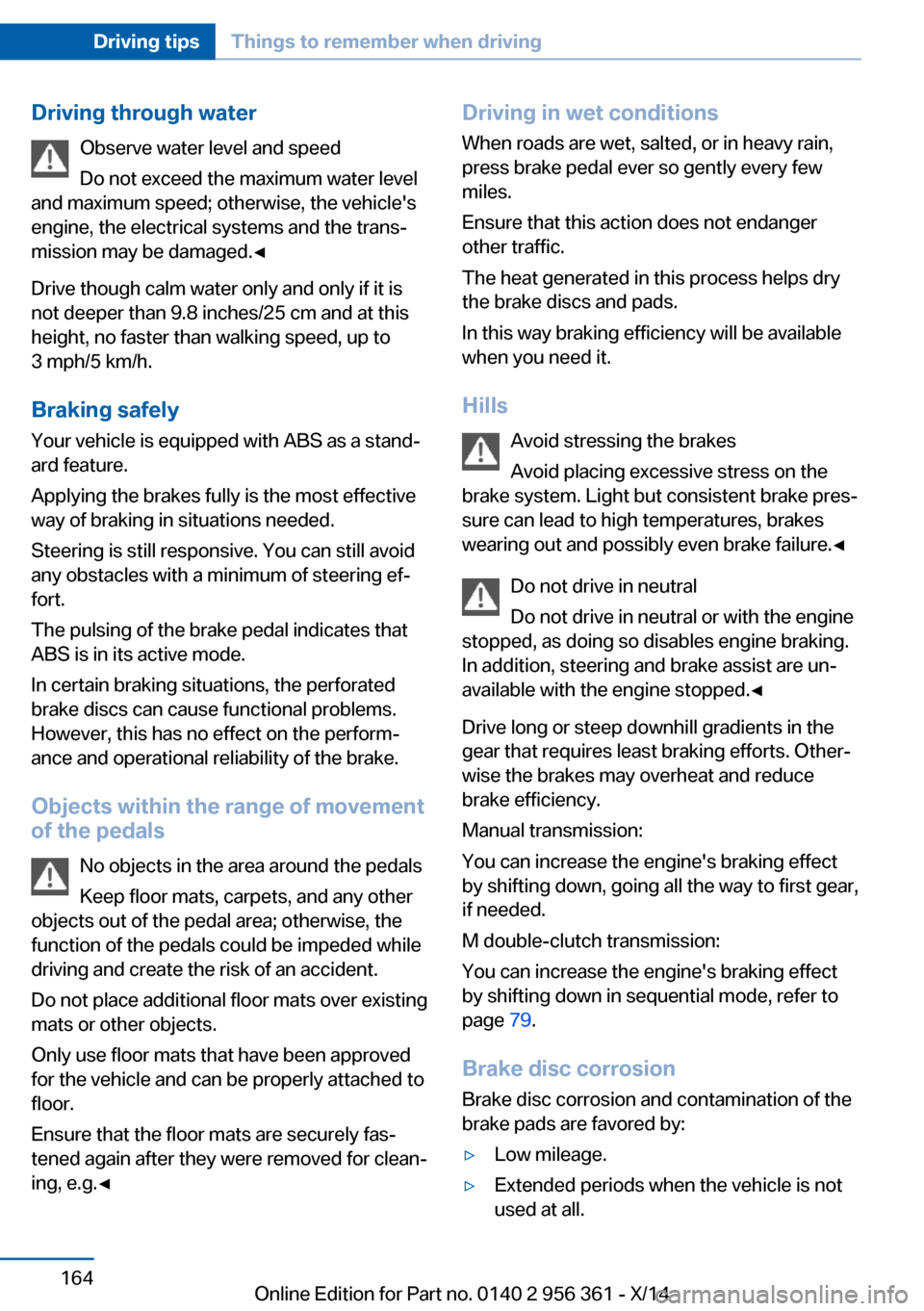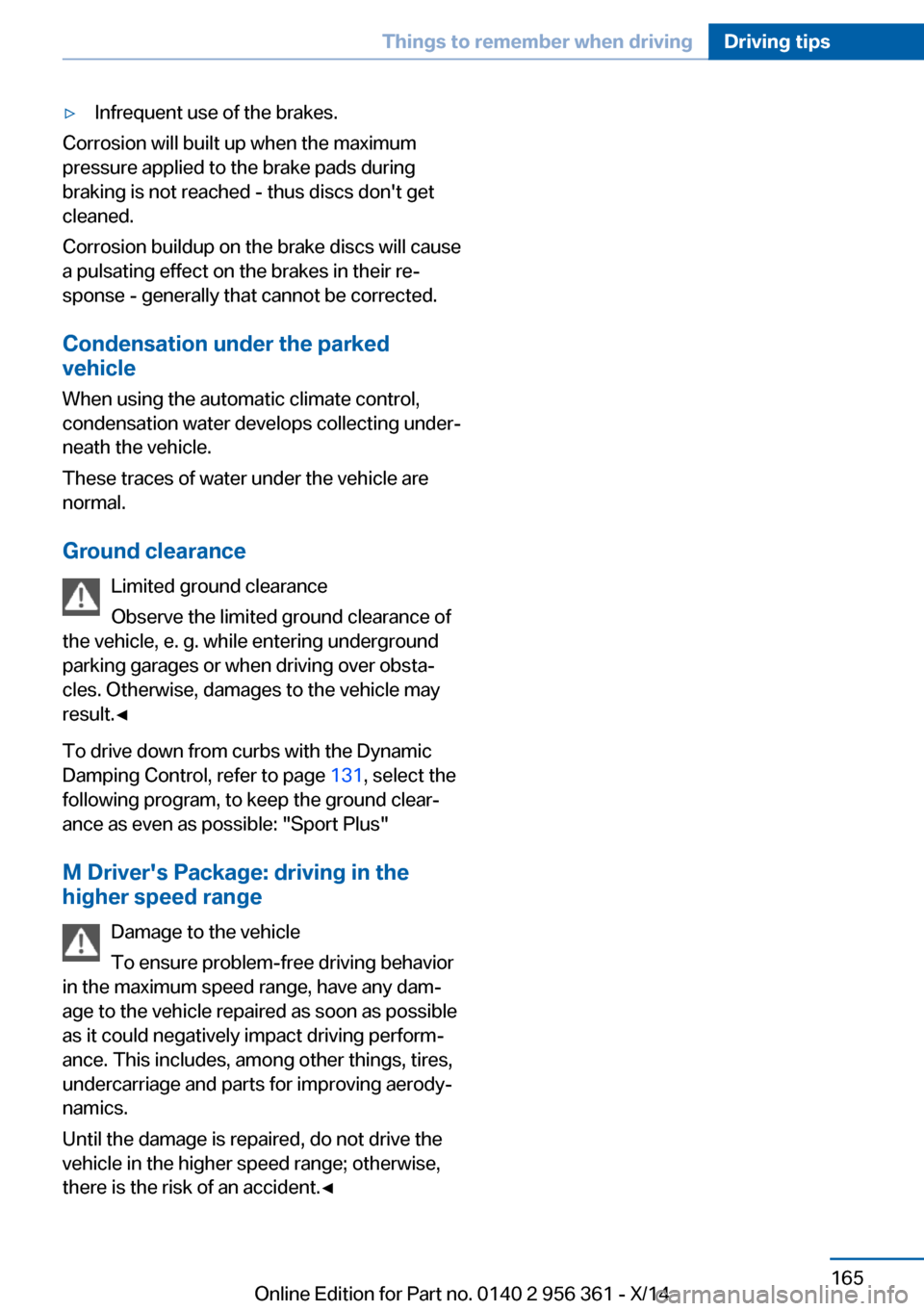2014 BMW M6 CONVERTIBLE brake pads
[x] Cancel search: brake padsPage 166 of 228

Things to remember when drivingVehicle features and options
This chapter describes all standard, country-
specific and optional features offered with the
series. It also describes features that are not
necessarily available in your car, e. g., due to
the selected options or country versions. This
also applies to safety-related functions and
systems.
Breaking-in period
General information Moving parts need time to adjust to one an‐
other (break-in time).
The following instructions will help accomplish
a long vehicle life and good efficiency.
During break-in, do not use the Launch Con‐
trol, refer to page 81.
Engine, transmission, and axle drive Always obey the official speed limit.
Up to 1,200 miles/2,000 km
Drive at varying engine and road speeds, but
do not exceed 5,500 rpm and
106 mph/170 km/h.
Avoid full load or kickdown under all circum‐
stances.
At 1,200 miles/2,000 km
Have drive-in checkup maintenance per‐
formed.
From 1,200 miles/2,000 km to 3,100 miles/5,000 km
The engine and road speed can gradually be
increased to a constant speed of
137 mph/220 km/h.Use the maximum speed of 155 mph/250 km/h
only briefly, e.g., when passing.
Tires
Tire traction is not optimal due to manufactur‐
ing circumstances when tires are brand-new;
they achieve their full traction potential after a
break-in time.
Drive conservatively for the first
200 miles/300 km.
Brake system
M Compound brakes require an initial break-in
period of approx. 300 miles/500 km to achieve
optimal performance between brake discs and
brake pads. Drive moderately during this
break-in period.
M carbon ceramic brakes require an initial
break-in period of approx. 600 miles/1,000 km
to achieve optimal performance between brake
discs and brake pads. Drive moderately during
this break-in period.
Clutch
The function of the clutch reaches its optimal
level only after a distance driven of approx.
300 miles/500 km. During this break-in period,
engage the clutch gently.
Following part replacement
The same break-in procedures should be ob‐
served if any of the components above-men‐
tioned have to be renewed in the course of the
vehicle's operating life.Seite 162Driving tipsThings to remember when driving162
Online Edition for Part no. 0140 2 956 361 - X/14
Page 168 of 228

Driving through waterObserve water level and speed
Do not exceed the maximum water level
and maximum speed; otherwise, the vehicle's
engine, the electrical systems and the trans‐
mission may be damaged.◀
Drive though calm water only and only if it is
not deeper than 9.8 inches/25 cm and at this
height, no faster than walking speed, up to
3 mph/5 km/h.
Braking safely
Your vehicle is equipped with ABS as a stand‐
ard feature.
Applying the brakes fully is the most effective
way of braking in situations needed.
Steering is still responsive. You can still avoid
any obstacles with a minimum of steering ef‐
fort.
The pulsing of the brake pedal indicates that
ABS is in its active mode.
In certain braking situations, the perforated
brake discs can cause functional problems.
However, this has no effect on the perform‐
ance and operational reliability of the brake.
Objects within the range of movement
of the pedals
No objects in the area around the pedals
Keep floor mats, carpets, and any other
objects out of the pedal area; otherwise, the
function of the pedals could be impeded while
driving and create the risk of an accident.
Do not place additional floor mats over existing
mats or other objects.
Only use floor mats that have been approved
for the vehicle and can be properly attached to
floor.
Ensure that the floor mats are securely fas‐
tened again after they were removed for clean‐
ing, e.g.◀Driving in wet conditions
When roads are wet, salted, or in heavy rain,
press brake pedal ever so gently every few
miles.
Ensure that this action does not endanger
other traffic.
The heat generated in this process helps dry
the brake discs and pads.
In this way braking efficiency will be available
when you need it.
Hills Avoid stressing the brakes
Avoid placing excessive stress on the
brake system. Light but consistent brake pres‐
sure can lead to high temperatures, brakes
wearing out and possibly even brake failure.◀
Do not drive in neutral
Do not drive in neutral or with the engine
stopped, as doing so disables engine braking.
In addition, steering and brake assist are un‐
available with the engine stopped.◀
Drive long or steep downhill gradients in the
gear that requires least braking efforts. Other‐
wise the brakes may overheat and reduce
brake efficiency.
Manual transmission:
You can increase the engine's braking effect
by shifting down, going all the way to first gear,
if needed.
M double-clutch transmission:
You can increase the engine's braking effect
by shifting down in sequential mode, refer to
page 79.
Brake disc corrosion
Brake disc corrosion and contamination of the
brake pads are favored by:▷Low mileage.▷Extended periods when the vehicle is not
used at all.Seite 164Driving tipsThings to remember when driving164
Online Edition for Part no. 0140 2 956 361 - X/14
Page 169 of 228

▷Infrequent use of the brakes.
Corrosion will built up when the maximum
pressure applied to the brake pads during
braking is not reached - thus discs don't get
cleaned.
Corrosion buildup on the brake discs will cause
a pulsating effect on the brakes in their re‐
sponse - generally that cannot be corrected.
Condensation under the parked
vehicle
When using the automatic climate control,
condensation water develops collecting under‐
neath the vehicle.
These traces of water under the vehicle are
normal.
Ground clearance Limited ground clearance
Observe the limited ground clearance of
the vehicle, e. g. while entering underground
parking garages or when driving over obsta‐
cles. Otherwise, damages to the vehicle may
result.◀
To drive down from curbs with the Dynamic
Damping Control, refer to page 131, select the
following program, to keep the ground clear‐
ance as even as possible: "Sport Plus"
M Driver's Package: driving in thehigher speed range
Damage to the vehicle
To ensure problem-free driving behavior
in the maximum speed range, have any dam‐
age to the vehicle repaired as soon as possible
as it could negatively impact driving perform‐
ance. This includes, among other things, tires,
undercarriage and parts for improving aerody‐ namics.
Until the damage is repaired, do not drive the
vehicle in the higher speed range; otherwise,
there is the risk of an accident.◀
Seite 165Things to remember when drivingDriving tips165
Online Edition for Part no. 0140 2 956 361 - X/14
Page 218 of 228

Everything from A to Z
IndexA ABS, Antilock Brake Sys‐ tem 129
Acceleration Assistant, refer to Launch Control 81
Activated-charcoal filter 147
Active Blind Spot Detec‐ tion 124
Active M differential 131
Active Protection 126
Active seat, front 57
Active seat ventilation, front 57
Adaptive brake lights, refer to Brake force display 126
Adaptive Light Control 102
Additives, oil 188
Adjusting, steering wheel 64
Adjustments, seats/head re‐ straints 55
After washing vehicle 206
Airbags 106
Airbags, indicator/warning light 107
Air circulation, refer to Recir‐ culated-air mode 146
Air, dehumidifying, refer to Cooling function 146
Air distribution, manual 145
Air flow, automatic climate control 146
Air outlets, see ventila‐ tion 148
Air pressure, tires 176
Alarm system 44
Alarm, unintentional 45
All around the center con‐ sole 16
All around the interior rear‐ view mirror 17 All around the steering
wheel 14
All-season tires, refer to Win‐ ter tires 181
Alternating-code hand-held transmitter 150
Alternative oil types 189
Ambient light 104
Animal detection, see Night Vision 119
Antifreeze, washer fluid 77
Antilock Brake System, ABS 129
Anti-slip control, refer to DSC 129
Approved axle load 212
Approved engine oils 189
Armrest, refer to Front center armrest 156
Arrival time 96
Ashtray 151
Assistance, Roadside Assis‐ tance 200
Assistance when driving off 129
Attentiveness assistant 126
AUTO intensity 145
Automatic car wash 205
Automatic Curb Monitor 62
Automatic deactivation, front- seat passenger airbags 108
Automatic headlight con‐ trol 102
Automatic locking 43
Automatic recirculated-air control 146
Automatic Soft Closing, doors 40
AUTO program, automatic cli‐ mate control 145
AUTO program, intensity 145 Auto Start/Stop function 71
Average fuel consumption 95
Average speed 95
Axle loads, weights 212
B Backrest curvature, refer to Lumbar support 56
Backrest, seats 55
Backrest, width 56
Band-aids, refer to First aid kit 200
Bar for tow-starting/ towing 203
Battery replacement, vehicle battery 197
Battery replacement, vehicle remote control 34
Battery, vehicle 197
Belts, safety belts 58
Beverage holder, cu‐ pholder 157
BMW Assist, see user's manual for Navigation, En‐
tertainment and Communi‐
cation
BMW maintenance sys‐ tem 191
BMW M technology 160
Bottle holder, refer to Cu‐ pholder 157
Brake assistant 129
Brake discs, break-in 162
Brake force display 126
Brake lights, adaptive 126
Brake lights, brake force dis‐ play 126
Brake lights, bulb replace‐ ment 195
Brake pads, break-in 162 Seite 214ReferenceEverything from A to Z214
Online Edition for Part no. 0140 2 956 361 - X/14